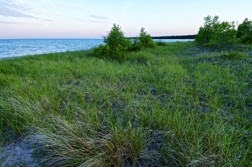The Economics of Conservation
- Share
- Tweet
- Pin
- Share

Earlier this year the Door County Land Trust used grants from the Knowles-Nelson Stewardship Fund to purchase 483 undeveloped, pristine acres just south of the Whitefish Dunes State Park. The property is part of the Shivering Sands State Natural Area (SNA) and houses 19 natural landscape communities. Photo by Len Villano.
A change to the Knowles-Nelson Stewardship Program has re-started discussion about the economics of conservation in Door County.
The Knowles-Nelson Stewardship Program was established by the state in 1989 to provide grant money to communities and non-profit organizations looking to preserve valuable natural areas and wildlife habitat.
In Door County, Knowles-Nelson funds have been used to purchase and preserve a significant number of natural areas. In 2009 alone, $3,531,651 in stewardship grants was used to purchase 1,178.8 acres. Recently, Knowles-Nelson funds were used to help the Door County Land Trust purchase 483 acres just south of Whitefish Dunes State Park in Sevastopol.
Due to a provision in Wisconsin’s 2011-13 biennial budget, the DNR must now notify each city, village, town or county of proposed acquisitions under the Knowles-Nelson Stewardship Program. Those entities then get a chance to support or oppose the acquisitions with a non-binding resolution. They can also choose to take no action at all.
One of these new notification letters came before the Door County Board of Supervisors at its June 26 meeting and led to talks about exactly how much land Door County should allow to leave the tax roll as a result of conservation.
“[With the acquisition in Sevastopol], it really doesn’t hurt the tax base that much,” said Supervisor and Sevastopol Town Board Chairman Leo Zipperer, “but if we allow this to continue we’re going to have to find another source to operate our government.”
Board Chairman Dan Austad said that he has begun looking through studies related to the economic impact of conservation. The board is also looking to compile data on exactly how much land in the county has been given over to conservancy and how that status affects tax funding.
“This has been a discussion for the last 50 years, 60 years,” said Austad. “If memory serves me correctly, [Whitefish Dunes State Park] was a controversial item back in the ‘60s, whether it should be a park and come off the tax roll.”
Dan Burke, Executive Director of the Door County Land Trust, came before the board and stated that, while his group does have lands that are tax-exempt, the majority of the Land Trust’s 6,000 acres are on the tax roll.

The Door County Land Trust used Knowles-Nelson Stewardship Funds to purchase 332 acres within the city of Sturgeon Bay in 2009. Along the south edge of the canal, the property was purchased from Sturgeon Bay Utilities and is open to low-impact recreational and educational uses such as swimming, hiking, wildlife viewing, school field trips, and research. Photo by Len Villano.
“I don’t have a specific figure, but I would estimate about 40 percent are tax-exempt,” said Burke.
All the Land Trust’s tax-exempt land is open to the public, said Burke, and is frequently used by school groups, hikers, and hunters.
“Property tax is a big issue,” he said, “but I do encourage you, if you want to pursue this debate, to broaden your scope to also include the community benefits to having community-based nature preserves throughout the county.”
The specific acquisitions that the board was notified of consist of 74.11 acres, 32 of which are located in Baileys Harbor and 44.11 of which are located on Washington Island. All of the land is located within established state natural areas and currently sits vacant.
“We’re not out there willy-nilly saying oh yeah, ‘Let’s buy this, buy that,’” said Burke. “We’re very focused on what we are determining to be the best of Door County.”
Burke also pointed to a University of Illinois study that the Land Trust and the Door County Environmental Council commissioned to document the average expenses and revenue generated by residential and open land in Gibraltar and Nasewaupee.
The study found that for every tax dollar collected from farms, forests and preserves in those towns, an average of $0.22 is kicked back out to provide services. For every dollar raised from the residential sector, the towns spend an average of $1.06 providing services.
At this point, the board has referred the matter and further discussion to its administrative committee.

